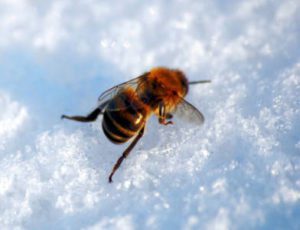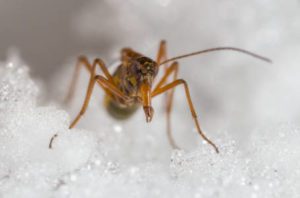What happens to insects when it snows?
By Zachary Ciras on January 7, 2022.

swarm of monarch butterflies, Danaus plexippus group during sunset
Migration to warmer climates
Famously, the Monarch Butterfly migration is investigated by researchers and amateur lepidopterists alike. The migration from Canada and the Northern United States occurs in the fall by a single generation of adult butterflies. An adult butterfly lives for only about four to five weeks. In this time, the generation of migrating Monarchs fly 1,900 miles to Central America. In the spring, these butterflies travel north, laying eggs and growing larvae along the way, which usually takes four or five generations to complete. The Greek origin for their name, Danaus plexippus means “sleepy transformation,” bringing to mind their ability to hibernate and metamorphose.
The “Globe Skimmer” dragonfly may travel over 11,000 miles during its annual migration between Africa and India, and others in the order Odonata migrate as well. Worldwide, large groups of moths and butterflies (Lepidoptera) migrate, as do some grasshoppers (Orthoptera), and insects in the order Coleoptera such as Ladybird beetles.
Some of the migration is on a grand scale to warm climates where insects can thrive and continue multiplying, and some of the movement appears to be in search of suitable sites in which to hibernate. Some pollinators such as bees, wasps, and hoverflies migrate to warmer climates, but most the insects around here are better suited to overwinter.
Overwintering

Pollinators
Pollinators have developed ways to perpetuate through time whilst withstanding brutally cold winters in the north. For the bumble bee, for example, the entire colony dies off save for the young queens, who consume large amounts of nectar to fill their honey stomachs, and overwinter in largely underground tree and root hollows or in the base of walls. Solitary bees are often only active a few months per year, so most of their time (including the winter) is spent in hollow reeds, trees, underground caverns, or the like. The European Honey Bee consumes its own honey over the winter t create energy to shiver around the queen to maintain her comfortable temperature. They increase the temperature around their queen even higher as she resumes egg laying.
Ants, wasps (Hymenoptera), and other insects
Ants are well-known to be a eusocial creature, working hard to prepare for the future. Ants will consume large amounts of food to use through the winter months. As the temperature declines, so does their energy level. Ants become very lethargic as they recede into their overwintering sites. These sites are often under ground, under stones, under bark, or within hollows. These hollows could be in trees or even in your house! Carpenter Ants, for example, will overwinter inside your wall voids waiting for the spring. It is not uncommon to see male King ants wondering around your home on warm days or when the heat kicks on.
Wasps, especially Paper Wasps (Polistes), can overwinter in voids or under the shingles of your home and likewise emerge on warm days as spring gets closer.
Many other insect species have developed their own means to prepare for the cold weather and overwinter in places outside or even inside of your home. The large, golden haired Cluster Fly enters through gaps and crack in the fall to overwinter, often in attic voids. Ladybugs, Western Conifer Seed Bugs, the Brown Marmorated Stink Bug, and boxelder bugs follow similar behaviors.
snow fleas or snow scorpions
Snow Scorpionfly

Snow scorpionfly on the snow
There is a little known insect family called Boreus, known commonly as snow scorpionflies. They are actually more closely related to fleas, so some have taken to calling them Snow Fleas. These insects (slightly larger than a house fly) are especially adapted to thriving in the snow and utilizing convection, radiation, and conduction in keeping warm. Despite the name, they are not Diptera (the order for flies) nor scorpions. They actually are more related to fleas.
According to reporting on iNaturalist, only a handful of scorpionfly observations have been reported in our service areas in MA and NH. If you find any, snap a pic and post it! They’re pretty cool animals who thrive in the cold and snow.
Snow Fleas (Springtails)
When you more commonly hear folks speaking about snow fleas, they’re probably talking about Springtails. Springtails (Collembola) are moisture and fungus seeking insects, who do stay active all year. Springtails are often called snow fleas, but they do not bite and they are not related to fleas. They are primarily found outside, but commonly seen inside as well, especially in home with moisture or fungus issues, or in window sills and near sinks and tubs. Species of Collembola have proteins which act as anti-freeze and can even survive in Arctic climates! These little buggers more indicate a potential moisture problem than cause their own trouble, besides being a nuisance.
Snow cover
While many insects are frozen and eliminated in frosty weather, more may actually benefit from a thick bed of snow. The snow cover can act as an insulated blanket and protect more than it destroys. A continuous snow bed for the coldest months in New England may result in a higher population of reproductive insects to emerge in the springtime. We see this trend with tick populations pretty regularly. When winters are bitter, wet, and have inconsistent snow cover, there appears to be less surviving individuals to propagate in the springtime.
Whatever the weather, Colonial Pest Control is here for you to control and prevent pest populations. Plus, there’s plenty of insects who thrive inside all year long! While our outside insect season in New England may be largely overwintering until things warm up, rodent control is firing on all cylinders! More on that next week. If there anything our experts can help you with, please don’t hesitate to give us a call at 800-525-8084 and we’ll be happy to hear from you. Until then, be well, stay healthy, and let it snow!